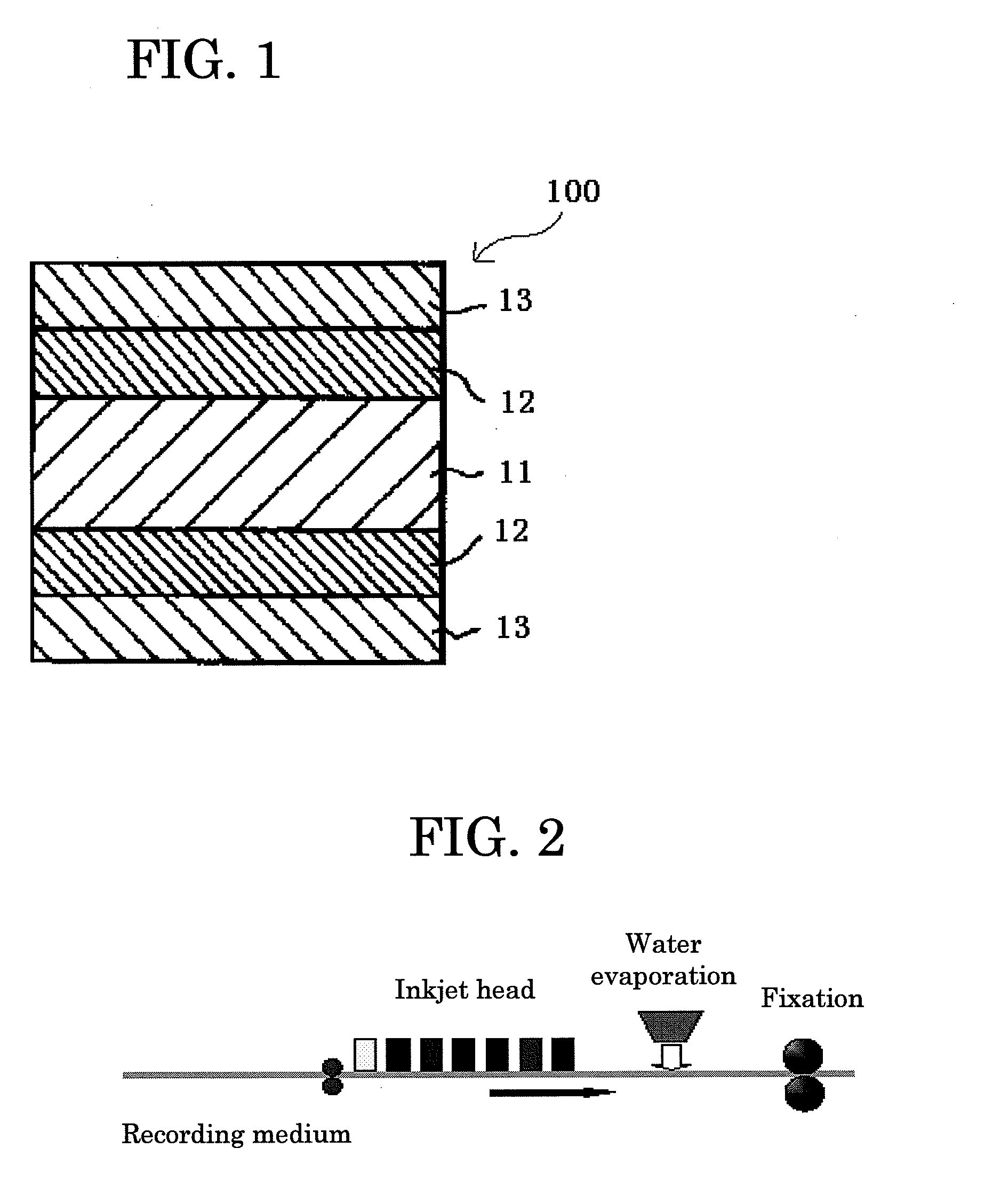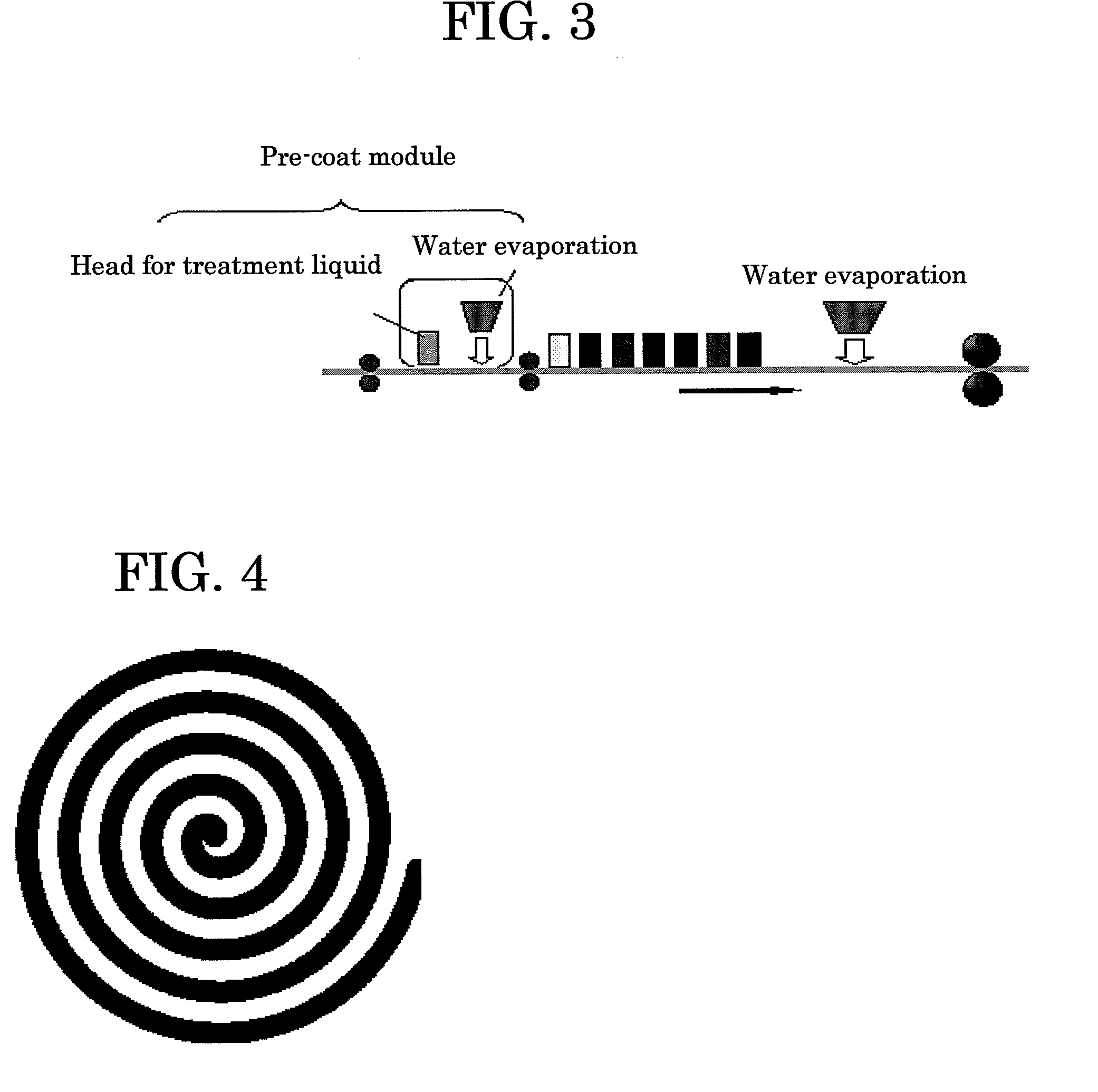Image forming method
a technology of image and forming film, which is applied in the direction of duplicating/marking methods, typewriters, printing, etc., can solve the problems of degrading the fixing property of the formed image, the ink-solvent permeability cannot be completely prevented from entering the base paper by the ink-absorbing layer, and the cost is increased, so as to achieve sufficient ink-solvent permeability, increase the strength of the formed film, and effectively prevent the effect of ink bleeding
- Summary
- Abstract
- Description
- Claims
- Application Information
AI Technical Summary
Benefits of technology
Problems solved by technology
Method used
Image
Examples
example 1
[0213](1) Preparation of acetoacetyl-modified polyvinyl alcohol
[0214]Water (88 parts) was added to acetoacetyl-modified polyvinyl alcohol (saponification degree: 95% to 97%; polymerization degree: 1,000; product name: Gosefimer Z-210 (product of Nippon Synthetic Chemical Industry Co., Ltd.)) (12 parts), and the resultant mixture was stirred at 90° C. or higher for dissolution.[0215](2) Water-swellable mica dispersion (aspect ratio: 1,000; product name: Somasif MEB-3 (8% solution) (product of CO-OP Chemical Co., Ltd.); average particle diameter of mica: 2.0 μm)[0216](3) Ethylene oxide surfactant (product name: Emulex 710 (product of Nihon-Emulsion Co., Ltd.) (1.66% by mass solution in methanol))
[0217]Water (58 parts) was added to the above-prepared (1) 12% by mass solution of acetoacetyl-modified polyvinyl alcohol (100 parts), followed by sufficiently stirring / mixing. Subsequently, the above (2) 8% by mass water-swellable mica dispersion (18 parts) was added to the resultant mixture,...
example 2
[0267]The procedure of Example 1 was repeated, except that an undercoat layer-coating liquid was prepared as described below, that the amount of the undercoat layer-coating liquid coated on one surface of woodfree paper was changed from 8.0 g / m2 to 10.0 g / m2, and that a soft calender treatment was carried out, to thereby perform an image forming method. The formed undercoat layer was found to have a thickness of 9.0 μm, and the formed overcoat layer 9.6 μm. Similar to Example 1, “test for Cobb-water absorption degree of woodfree paper with undercoat layer being formed thereon,”“water absorption test for woodfree paper with undercoat layer and overcoat layer being formed thereon,”“test for bleeding of ink printed,”“curling test” and “test for abrasion resistance” were performed. The results are shown in Table 1.
[0268]Titanium dioxide (product name: Taque R-780, product of ISHIHARA SANGYO KAISHA, LTD.) (100 parts), 25% special polycarboxylic acid polymer Na salt (product name: DEMOL E...
example 3
[0271]The procedure of Example 1 was repeated, except that an undercoat layer-coating liquid was prepared as described below, that an undercoat layer is formed as described below, that an overcoat layer-coating liquid was prepared as described below, that an overcoat layer was formed as described below, and that a soft calender treatment was carried out, to thereby perform an image forming method.
[0272]Kaolin (product name: Kaobrite 90, product of SHIRAISHI CALCIUM KAISHA, LTD.) (100 parts), 0.1N sodium hydroxide (product of Wako Pure Chemical Industries, Ltd.) (3.8 parts), 40% sodium polyacrylate (product name: ARON P50, product of TOAGOSEI, CO., LTD.) (1.3 parts) and water (49.6 parts) were mixed one another, and the resultant mixture was dispersed with a non-bubbling kneader (product name: NBK-2, product of NISSEI Corporation), to thereby prepare a 65% kaolin dispersion. Subsequently, the thus-prepared 65% kaolin dispersion (7.0 parts), water (5 parts) and 10% Emulgen 109P (produ...
PUM
| Property | Measurement | Unit |
|---|---|---|
| surface tension | aaaaa | aaaaa |
| viscosity | aaaaa | aaaaa |
| thickness | aaaaa | aaaaa |
Abstract
Description
Claims
Application Information
 Login to View More
Login to View More - R&D
- Intellectual Property
- Life Sciences
- Materials
- Tech Scout
- Unparalleled Data Quality
- Higher Quality Content
- 60% Fewer Hallucinations
Browse by: Latest US Patents, China's latest patents, Technical Efficacy Thesaurus, Application Domain, Technology Topic, Popular Technical Reports.
© 2025 PatSnap. All rights reserved.Legal|Privacy policy|Modern Slavery Act Transparency Statement|Sitemap|About US| Contact US: help@patsnap.com



